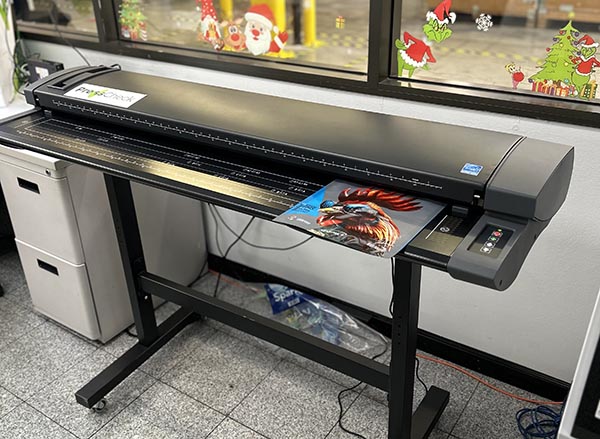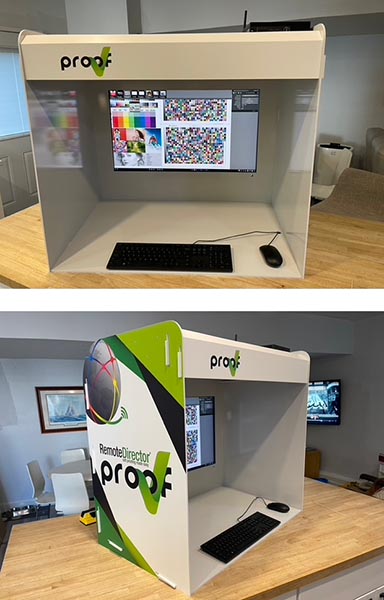Background
Color proofing has an interesting history. Before the 1970s, on-press proofing was the norm. Customers would come to the printing plant and either stand press side or relax in a conference room waiting to approve that the press sheet represented their expectations. Very time-consuming and expensive, although an “earned boondoggle” to some. To help replace this, off-press overlay color proofing systems exposed with the separation films were initially developed in the late 1940s, but really took off in the late 1960s with the introduction of 3M Color Key. Laminated off-press color proofing took hold in the mid 1970s with the introduction of products by 3M, Dupont, Kodak, and others. While they were not as accurate as on press proofing, for “some” less critical color applications they would suffice. After all, clients didn’t need to come to the printing plant and the proofs could be sent by mail or courier, saving time and costs.
By the 1980s, digital design and prepress became the norm, and the concept of “soft proofing” or reviewing color and making approvals on a monitor started to take hold. While these were good for content approval, color approval was less so. But ultimately, it was still faster and less costly to email a PDF file directly to a client, eliminating the creation and mailing of a hard copy a proof, without the dark hole window of transport. While to many this became the method of choice, it had and has its problems. The introduction of ICC color management and profile support in computer operating systems, creative applications, and prepress systems helped, however it still assumed that all of the players in the design and production supply chain not only had compliant systems, but more importantly that they were set up properly. In essence, does it really look the same on my monitor as it does on yours, and, most importantly, the press? We think that anytime you’re passing PDFs around, you can say you’re soft proofing, but there are hidden if not obvious problems. What monitors does everybody have? Do they calibrate them? When do they calibrate them? Do they pass ISO certification? What profiles are they using? Have they specified and controlled the lighting? Is there a press curve that needs to be applied to the file, etc.?

This is all very critical if you are trying to ensure and maintain brand identity in packaging or marketing. Inkjet proofing provides some of that process control, but now we were back to making and sending hard copy proofs, or relying on each of the stakeholders to maintain and calibrate their local proofing systems and, as important, the viewing environment.
Digital Color Proofing
Controlled digital proofing systems that ensure proper setup and maintenance if each of the stakeholders had a corresponding system seemed to be the answer. There have been a number of systems introduced that endeavored to achieve that goal, but never seemed to be able to maintain that needed level of control across the stakeholder teams.
 ICS President Dan Caldwell and the ICS Color team has been looking at these problems since their introduction of ColorBlind ICC profiling software in 1994. In 2003, they applied for and ultimately received a world and subsequently a US patent for “a system and method for creating characterization information from a first display device that can be transmitted and used by a second display device.” Ultimately, this went a long way toward solving the shortcomings of soft proofing. Since then, they have introduced Remote Director, ProofCheck, PressCheck, and some OEM solutions that translated that patent into successfully working technology, ideal for color-critical brand and packaging applications and workflows.
ICS President Dan Caldwell and the ICS Color team has been looking at these problems since their introduction of ColorBlind ICC profiling software in 1994. In 2003, they applied for and ultimately received a world and subsequently a US patent for “a system and method for creating characterization information from a first display device that can be transmitted and used by a second display device.” Ultimately, this went a long way toward solving the shortcomings of soft proofing. Since then, they have introduced Remote Director, ProofCheck, PressCheck, and some OEM solutions that translated that patent into successfully working technology, ideal for color-critical brand and packaging applications and workflows.
The Proof Is in the Viewing
A Design to Print Lead for a large CPG oversees a lot of the process flow work with all their cross-functional teams. Caldwell shared, “Ultimately, we have to make sure that packaging is accurate and it’s ready, so when that material gets to our manufacturing sites there are no questions being asked.”
Driving their and most CPGs’ focus is “time to market” or, from a brand perspective, how do we get products out on the shelf sooner, faster and accurately? The answer is “the digital realm, since it gets us live and we’re there all the time. We need to do this live, and manage the multiple changes, while—importantly—keeping the supply chain as part of it.” There are many pros and cons of bringing the workflows in house, and ultimately it’s important to understand what you can do, and how do you control it. “I believe that our supply chain is critical, and I have workflow connections to our production houses and to some of our printers, so I’m regularly pushing things to them and they’re pushing things back into me, and that’s pretty critical.”
When you are talking about an optimized and connected supply chain, it’s about creating standards and streamlining it. There needs to be regular communication on how you can improve things. “One of the big things we did was to bring in Proof Check for digital color proofing. We started testing in January 2021, and once we saw the quality and accuracy of the color proof, we moved really quick, and by the end of the first quarter, we removed all random color proofs coming into the company.”

They onboarded their pre-media suppliers with their own onsite Proof Checks in February and ran parallel path workflows, which they were able to eliminate pretty quickly. “In 2022, we started out with three Proof Check machines, and I have three of these devices in my control, one here and two at my pre-media houses. We’ve installed a third one with a new pre-media company, and I’m also doing beta work with a large-format printer and wide-web printer right now.” They saw immediate benefits on their side by not having to track all of those proofs. This solution has now replaced an army of inkjet proofers, and importantly made managing the thousands of proofs much easier.
Prepress Supplier’s View
Kevin Bourquin has been in Packaging Workflow technology for about 20 years. During that time, he has been a prepress manager, VP of Operations at Cyber Graphics, and now the General Manager of Fortis Solutions Group in Atlanta. He has watched and had years of experience with color proofing and in 2008 started the digital color proofing journey first internally and then working with his CPG client base.
“Labor is a challenge, and we’re often trying to load balance our business. You don’t add a resource until you can guarantee you’ve got that new labor position full all the way,” according to Bourquin. “We found we were able to leverage this technology and utilize the resources that we already had and pass work back and forth between our multiple sites. So one site could color correct for another site. We could do internal approvals of jobs as we’re working on them and get real-time feedback from other color operators on really challenging profiles and substrates. It then enabled us to get all profiles stored in a central location on central server.
“We determined that this solution would also be good for many of our CPG customers,” he added. “Previously, we had placed inkjet proofers in many of their sites, but there wasn’t enough volume to even maintain the device. Just keeping it at a stable state is very challenging to do.” Then came the pandemic and they found their customers requesting them to prepare and ship two or three proofs to a variety of locations including offices, hotels, the resort that they were staying at, or working from home. “We were tripling the cost of for customers with how shipping was pushed all around, and it was very difficult for them to manage.”
At the same time, they were also losing control of their viewing environments. “We couldn’t guarantee they’re going to be in a light booth like they may have in their office.” By migrating to this technology, you can guarantee your customers are looking at something collaborative. They’re tied into a light booth in a much smaller footprint, and you can see how your colors can look at the same time, and you can instantly show changes. If you wanted to change a profile, you could compare it to any of the standards, and could show the effective change on a variety of substrates, press types, etc.
Change Management Is the Key
Most of the brands, prepress companies, and converters can probably understand the same pain that most CPGs are dealing with day in, day out. However, as someone who has spent much of my career in “change management,” it is important that all of the stakeholders are onboard when you make this type of change. It is equally as important that you jump in sooner rather than later, although rolling it out in phases makes sense and reduces pain. There will always be bugs and things that can be improved, but the benefits usually outweigh the immediate drawbacks.
Where Do We Go From Here?
Quite a few CPGs have already started testing this digital color workflow with one of their converters with a connected proofer at the press with some early success. There are an increasing number of CPGs, that have implemented this solution in their supply chain with great success. Getting it to the press is an important part of that, and since many or most of the presses out there have integrated displays in their control and viewing console, we could expect that this technology can be adapted to work with them as well. This will undoubtedly help, control and streamline the process, leading CPGs to quicker time to market.
More to Come…
drupa 2024 is right around the corner and it will be an exciting one. I would like to address your interests and concerns in future articles as it relates to the manufacturing of Print, Packaging, and Labels, and how, if at all, it drives future workflows including “Industry 4.0.” If you have any interesting examples of hybrid and bespoke manufacturing, I am very anxious to hear about them. Please feel free to contact me at [email protected] with any questions, suggestions, or examples of interesting applications.














